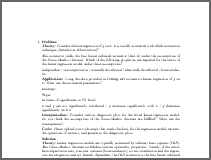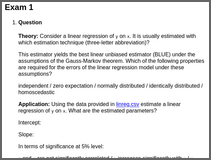lm3: Simple Linear Regression (Cloze with Theory, Application, Essay, and File Upload)
lm3Theory: Consider a linear regression of y on x. It is usually estimated with which estimation technique (three-letter abbreviation)?
This estimator yields the best linear unbiased estimator (BLUE) under the assumptions of the Gauss-Markov theorem. Which of the following properties are required for the errors of the linear regression model under these assumptions?
Application: Using the data provided in linreg.csv estimate a linear regression of y on x. What are the estimated parameters?
Intercept:
Slope:
In terms of significance at 5% level:
Interpretation: Consider various diagnostic plots for the fitted linear regression model. Do you think the assumptions of the Gauss-Markov theorem are fulfilled? What are the consequences?
Code: Please upload your code script that reads the data, fits the regression model, extracts the quantities of interest, and generates the diagnostic plots.
Theory: Linear regression models are typically estimated by ordinary least squares (OLS). The Gauss-Markov theorem establishes certain optimality properties: Namely, if the errors have expectation zero, constant variance (homoscedastic), no autocorrelation and the regressors are exogenous and not linearly dependent, the OLS estimator is the best linear unbiased estimator (BLUE).
Application: The estimated coefficients along with their significances are reported in the summary of the fitted regression model, showing that x and y are not significantly correlated (at 5% level).
Call:
lm(formula = y ~ x, data = d)
Residuals:
Min 1Q Median 3Q Max
-0.55258 -0.15907 -0.02757 0.15782 0.74504
Coefficients:
Estimate Std. Error t value Pr(>|t|)
(Intercept) -0.007988 0.024256 -0.329 0.743
x -0.031263 0.045420 -0.688 0.493
Residual standard error: 0.2425 on 98 degrees of freedom
Multiple R-squared: 0.004811, Adjusted R-squared: -0.005344
F-statistic: 0.4738 on 1 and 98 DF, p-value: 0.4929Interpretation: Considering the visualization of the data along with the diagnostic plots suggests that the assumptions of the Gauss-Markov theorem are reasonably well fulfilled.
Code: The analysis can be replicated in R using the following code.
## data
d <- read.csv("linreg.csv")
## regression
m <- lm(y ~ x, data = d)
summary(m)
## visualization
plot(y ~ x, data = d)
abline(m)
## diagnostic plots
plot(m)Theory: Consider a linear regression of y on x. It is usually estimated with which estimation technique (three-letter abbreviation)?
This estimator yields the best linear unbiased estimator (BLUE) under the assumptions of the Gauss-Markov theorem. Which of the following properties are required for the errors of the linear regression model under these assumptions?
Application: Using the data provided in linreg.csv estimate a linear regression of y on x. What are the estimated parameters?
Intercept:
Slope:
In terms of significance at 5% level:
Interpretation: Consider various diagnostic plots for the fitted linear regression model. Do you think the assumptions of the Gauss-Markov theorem are fulfilled? What are the consequences?
Code: Please upload your code script that reads the data, fits the regression model, extracts the quantities of interest, and generates the diagnostic plots.
Theory: Linear regression models are typically estimated by ordinary least squares (OLS). The Gauss-Markov theorem establishes certain optimality properties: Namely, if the errors have expectation zero, constant variance (homoscedastic), no autocorrelation and the regressors are exogenous and not linearly dependent, the OLS estimator is the best linear unbiased estimator (BLUE).
Application: The estimated coefficients along with their significances are reported in the summary of the fitted regression model, showing that x and y are not significantly correlated (at 5% level).
Call:
lm(formula = y ~ x, data = d)
Residuals:
Min 1Q Median 3Q Max
-0.48440 -0.14690 0.00744 0.14566 0.60770
Coefficients:
Estimate Std. Error t value Pr(>|t|)
(Intercept) 0.01374 0.02329 0.590 0.556
x 0.01099 0.03948 0.278 0.781
Residual standard error: 0.2317 on 98 degrees of freedom
Multiple R-squared: 0.0007899, Adjusted R-squared: -0.009406
F-statistic: 0.07748 on 1 and 98 DF, p-value: 0.7813Interpretation: Considering the visualization of the data along with the diagnostic plots suggests that the assumptions of the Gauss-Markov theorem are reasonably well fulfilled.
Code: The analysis can be replicated in R using the following code.
## data
d <- read.csv("linreg.csv")
## regression
m <- lm(y ~ x, data = d)
summary(m)
## visualization
plot(y ~ x, data = d)
abline(m)
## diagnostic plots
plot(m)Theory: Consider a linear regression of y on x. It is usually estimated with which estimation technique (three-letter abbreviation)?
This estimator yields the best linear unbiased estimator (BLUE) under the assumptions of the Gauss-Markov theorem. Which of the following properties are required for the errors of the linear regression model under these assumptions?
Application: Using the data provided in linreg.csv estimate a linear regression of y on x. What are the estimated parameters?
Intercept:
Slope:
In terms of significance at 5% level:
Interpretation: Consider various diagnostic plots for the fitted linear regression model. Do you think the assumptions of the Gauss-Markov theorem are fulfilled? What are the consequences?
Code: Please upload your code script that reads the data, fits the regression model, extracts the quantities of interest, and generates the diagnostic plots.
Theory: Linear regression models are typically estimated by ordinary least squares (OLS). The Gauss-Markov theorem establishes certain optimality properties: Namely, if the errors have expectation zero, constant variance (homoscedastic), no autocorrelation and the regressors are exogenous and not linearly dependent, the OLS estimator is the best linear unbiased estimator (BLUE).
Application: The estimated coefficients along with their significances are reported in the summary of the fitted regression model, showing that y decreases significantly with x (at 5% level).
Call:
lm(formula = y ~ x, data = d)
Residuals:
Min 1Q Median 3Q Max
-0.62441 -0.14064 -0.00358 0.13978 0.54380
Coefficients:
Estimate Std. Error t value Pr(>|t|)
(Intercept) -0.00383 0.02331 -0.164 0.87
x -0.76385 0.03945 -19.362 <2e-16
Residual standard error: 0.2315 on 98 degrees of freedom
Multiple R-squared: 0.7928, Adjusted R-squared: 0.7907
F-statistic: 374.9 on 1 and 98 DF, p-value: < 2.2e-16Interpretation: Considering the visualization of the data along with the diagnostic plots suggests that the assumptions of the Gauss-Markov theorem are reasonably well fulfilled.
Code: The analysis can be replicated in R using the following code.
## data
d <- read.csv("linreg.csv")
## regression
m <- lm(y ~ x, data = d)
summary(m)
## visualization
plot(y ~ x, data = d)
abline(m)
## diagnostic plots
plot(m)Demo code:
library("exams")
set.seed(403)
exams2html("lm3.Rmd")
set.seed(403)
exams2pdf("lm3.Rmd")
set.seed(403)
exams2html("lm3.Rnw")
set.seed(403)
exams2pdf("lm3.Rnw")


